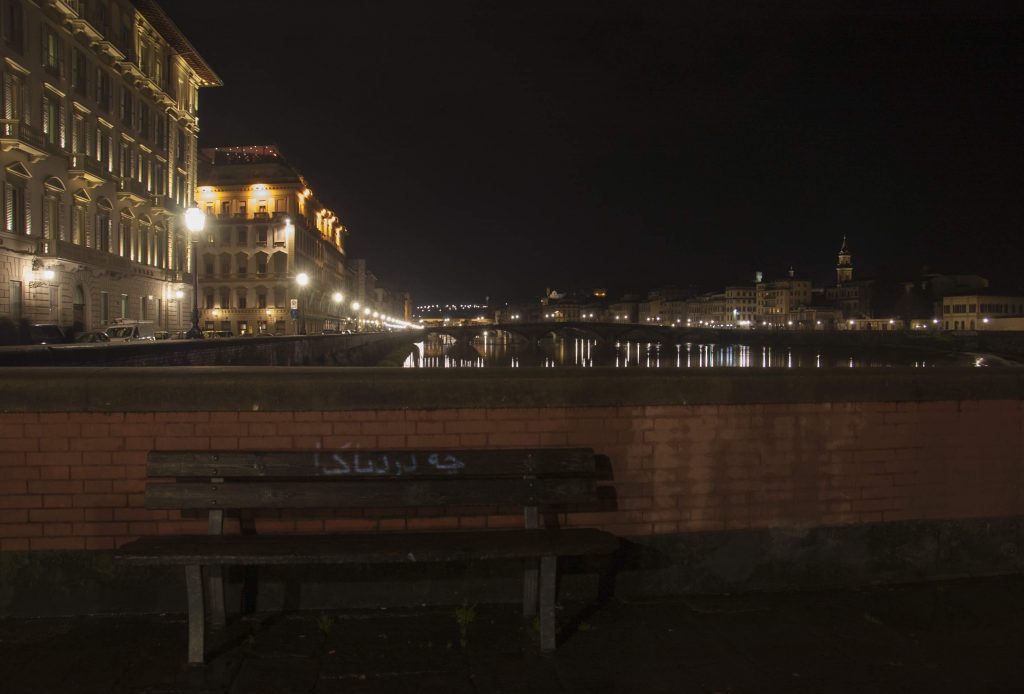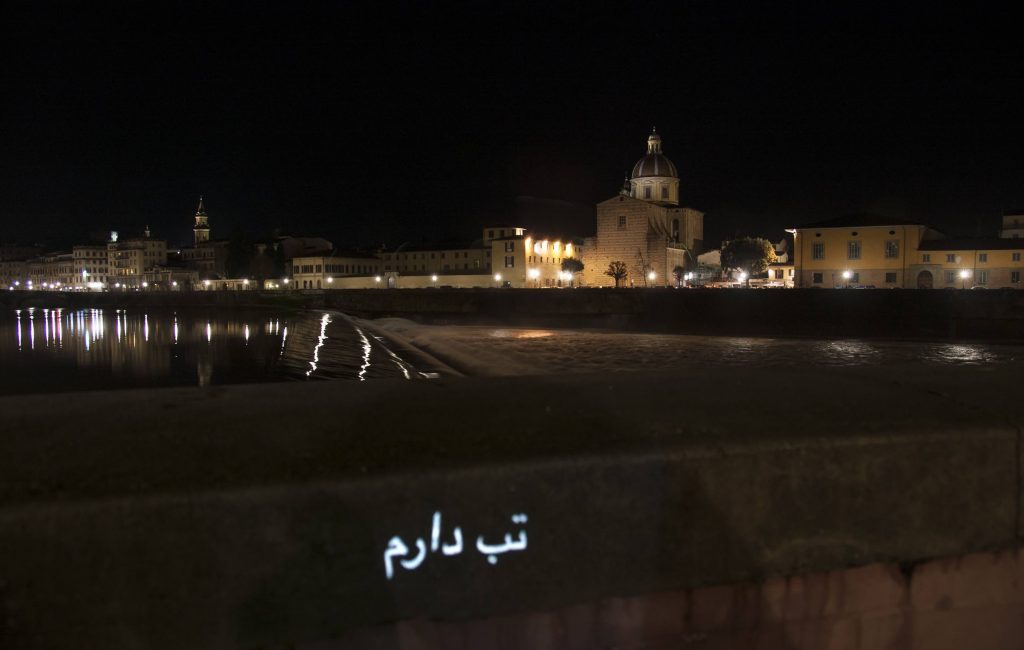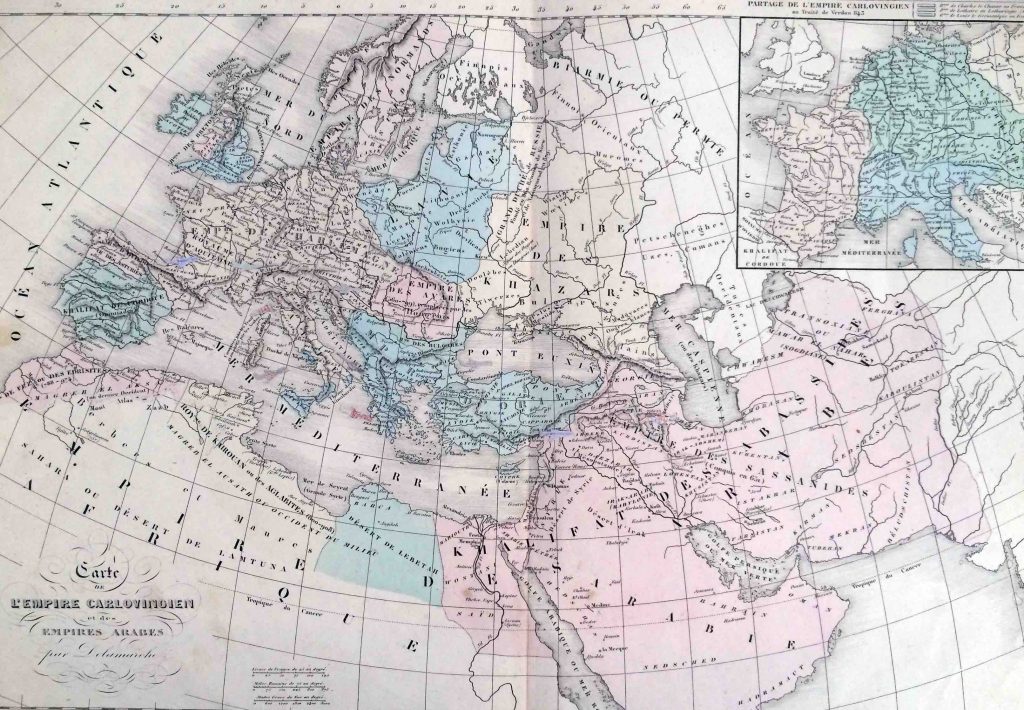Mona Mohagheghi (Teheran, 1981) graduated in Mathematics and attended the Academy of Florence where she studied Painting and New Expressive Languages. She recently returned to Italy after studying in London. Her practice develops through a conceptual thought that finds formalization in works of different nature. Languages intertwine – installations, videos, performance, collage, visual poetry – to return intense and layered works. The cultured and refined investigation finds its representation in the elegant works, delicate but powerful.

Mona Mohagheghi
Other Gases, 2020
3 channel video installation
Courtesy the artist
Elena Solito: Several artists start from an academic education seemingly distant from art. You graduated in Mathematics and then studied art first in Tehran and then in Florence. How did “Knot Theory” lead you to art?
Mona Mohagheghi: For me I suppose, some contents of topology like the knots or open and closed curves were those aspects of Mathematics that are closely connected with imagination. Maybe it was the logic of forms, their complexity and their relation to other forms that somehow led me to art. It’s all very vague to be honest! All I remember is that one day during the knot theory course, I was so fascinated by all those forms and their relation to space, that I decided to start drawing. There is, however, no trace of Mathematics in my works!
E.S.: In your research there are recurring themes: identity, migrations, conflict, time. What role does the socio-political issue play for you in your work?
M.M.: We live in difficult times of our collective history. I believe that art can open up new avenues of reflection…new spaces. Spaces where new subjectivities can be rewritten, and where alternatives to the current situation in which we live can be reimagined. In view of this, art defines itself as deconstruction, decoding values and norms. It opens up a space in our imagination to see reality differently and reconsider the boundaries between the supposedly normal and the subversive in our minds. In my research I am interested in pushing against the dominant narratives of our world. There are some of my works that critically reflect on the global socio-political realities but there are also some other works that are more intimate. They are formed through the recounting of a personal story.
E.S.: The outcome of your last London academic career on the relationship between Art and Politics led you to realize projects with a very powerful emotional and visual charge. I think of the strength of Other Gases.
M.M.: Other Gases aims to highlight a fact not relayed to the public regarding the safety of lachrymatory agents. Banned as a method of warfare, tear gas still stands as a viable option for domestic police enforcement. Other Gases is a three channel video installation in which performers read the articles of the Chemical Weapon Convention on riot-control agents, in different languages. After a few seconds, the performers begin to feel irritation in their eyes, nose, and throat and struggle really hard to keep on reading or even to keep their eyes open. This condition was caused by onions being grated and chopped at a very short distance from them. When cut open, onions release a chemical that combined with enzymes, turns into sulfur gas and causes tearing. This is similar to the tear gas effect which gets worse the longer one is exposed to it. Despite its toxic properties and despite being a chemical weapon, tear gas is considered harmless to use in times of peace in every corner of the world: from Hong Kong to France, from Gezi movement to the refugees being gassed when crossing borders. In Chile, the daily use of tear gas during the demonstration in 2019 has made this dangerous chemical weapon a part of the quotidian life. And as we saw just recently in 2020, this toxic weapon was used by the police in the Black Lives Matter demonstrations in different parts of the US.

Mona Mohagheghi
How painful!
From Untitled series 2014, Florence
Fine art print on aluminium dibond
Courtesy the artist
Mona Mohagheghi
I have a fever!
From Untitled series 2014, Florence
Fine art print on aluminium dibond
Courtesy the artist
E.S.: And the Room 52?
M.M.: Room 52 is a guide through the Iran room at the British Museum presented in the form of a performance lecture. The guide starts like a normal museum audio tour with the description of the objects, but then after a few seconds, the visitor is lured into an unexpected story. The objects of this room have been associated with a chronology of events starting from Britain’s interest in the oil-production potential of Persia and the formation of Anglo-Persian Oil Company. This guide re-narrates the ancient historical objects to tell the not well-known (in the west) story of the US and UK led 1953 coup in Iran. It tends to re-articulates the Iran room; to make it speak an alternative narration of Iran’s past and the UK’s long-standing neo-colonial interventions in the region. My focus in this project in fact was not centred around questions of repatriation, but deeper questioning of the part the museum played in colonial exploitation. It was a way of countering how the collection of the museum is perceived, seeing it from a different perspective, and rethinking it from a non-institutional point of view. The British Museum and multinational oil and gas company BP, have a partnership since 1996. Various exhibitions and public events of the museum were sponsored by BP. Many know that BP is responsible for several environmental disasters, in particular the oil leak in the Gulf of Mexico in 2010. But not so many people know that the harm caused by this company is not only environmental. The history of the company now called BP, is intertwined with imperialism. BP, originally known as Anglo-Persian Oil Company, monopolized Iran’s oil production and exportation for four decades. Due to covid restrictions I presented Room 52 as an online lecture performance, but in the upcoming months I will do the performance in person at the museum.
E.S.: In works such as In this space, 1 out of 3 breaths that you breathe in, is polluted or in Untitled 2015 you addressed the issue of international sanctions imposed on Iran and its consequences. Tell me about those works.
M.M.: Both works reflect on how the sanctions have affected the economically and socially disadvantaged citizens in Iran. In this space, 1 out of 3 breaths that you breathe in, is polluted in particular focuses on air pollution. The blockage of the crude oil exports forced the country to employ technologically primitive methods for refining it locally. The end product, mostly used in automobiles as fuel, turned out to be a highly polluting substance. During a period of 10 years from 2006 to 2016, a total of 1237 days were indicated as high-risk for the air quality, an equivalent of 33% of the days in a year; one day out of three. The death rate in the country increased by 181% only in Tehran, much of it attributed to the pollution level. In this space, 1 out of 3 breaths that you breathe in, is polluted the visitor is placed at the center of a temporal space (between 2 wall calendars of the years 2006 and 2016), allowing them to physically become a part of it while looking at the text in forex inscription on the wall.

Mona Mohagheghi
Untitled (detail), 2017
Cut out from passports on vintage map
Courtesy the artist
E.S.: You conducted an interesting survey on identity and migration, in particular to the role of the identity document as a proof of a person’s existence. Its presence defines us and its absence makes us invisible.
M.M.: Living in Europe and being categorized as a non-EU citizen can deprive you of some rights. At a first glance they might seem insignificant, but then one notices how in daily situations this categorization takes away opportunities from them or sometimes might result in being treated differently. I’m really interested in decontextualizing identity/travel documents. I did a few works using passports (mine and other people’s) and the border stamps on their pages. The passport is a document of both travel and recognition. The visas and the entry/exit border stamps, render visible the existence of the boundaries and differences. I use the passport stamps as a visual element to address the question of inclusion and exclusion and the construction of limits and barriers. For me the passport is also a metaphor for identity and displacement. I see identity here not only as something static defined in relation to the roots, but also an identity as something fluid that is always subject to change and transformation due to immigration and exposure to multiple cultures.
E.S.: Despite the production of works, your work is deeply conceptual. You analyze mechanisms, phenomena, rituals, places or the variables of time, around which you build a narrative. (I’m thinking of Untitled 2012, in Caffè; A local/golbal/Social connection, Here is always elsewhere, or Untitled 2014, Between and A map for the waiting times).
M.M.: I have always been interested in the perception of time and space. In most of the projects you mentioned, the concept of time has a strong presence. In these projects I used mapping and remapping as a method to perceive the space and the urban settings. And countermapping as a practice to challenge the natural order of narratives, as you see in A map for the waiting times for instance, where I compare my perception of time to that of an average Palestinian who has to wait for hours everyday to cross a checkpoint. To me maps are somehow an interpretation of that territory by collecting memories, experiences and impressions of that territory by those who designed it. Perhaps each mapping comes from a desire to narrate and tell. Tell a personal story that is part of the collective story building together a shared experience. Walking is an activity of mapping at a scale of one-to-one. It’s a way of taking possession of places that want to be seen and heard, to get in touch with the place and start a dialogue with it. When walking, I lose track of my thoughts, my steps mark my presence, my story intersects with those of the others. This is the approach you see for example in Untitled 2014 projections or in Here is always somewhere else. In Here is always somewhere else I ask passers-by for directions showing them modified maps of streets of Tehran juxtaposed on Florence map and vice versa. Not being able to recognize the reference points on the map, people get bemused. In their own neighborhood, their own world, they get lost. The phenomenon of not fully possessing either of the two places (the home town and the new one) after immigration is a common thing felt by many immigrants. A condition in which the space belongs less and less to those who inhabit it. This is the idea behind Between, a neon light installation showing the distance between Tehran and Florence, between the two reference points, a space that can not be measured nor planned, but only felt.

Mona Mohagheghi
Untitled, 2015
Postcards, passport, “Getting Lost with Julie Mehretu”, at Botin Foundation, Santander
Courtesy the artist
E.S.: What role does performance play?
M.M.: In my older works I used to perform myself, but now I really like to collaborate with performers. Furthermore, I am becoming more and more interested in using a combination of performance, storytelling, video materials from the web, theoretical reflections, etc. In particular I find lecture-performance an intriguing practice because of its hybrid nature.
E.S.: Today, the artist is less and less rooted in one place. You also have this nomadic tendency. What does this constant displacement mean and where do you imagine or plan to go as soon as the current situation allows?
M.M.: I think this constant displacement comes from the dynamic or fluid identity I was telling you about earlier. I feel like I am always ready to move and to explore a new place, but at the same time I am sure that I will come back to the places that I have lived. Mainly because of the people I have met in those places and the memories I’ve had. I have to say that this nomadic tendency is sometimes a bit stressful but pays off most of the time. As for the plans, I should say that after the pandemic and all we’ve been through, I still find it a little bit early to decide. I need to wait and see how things will be in the next few months.
E.S.: What are you working on? What plans do you have for the future?
M.M.: One day during the (second) lockdown while I was cooking, I was also on the phone having a conversation with a friend who lives on the other side of the world. I was giving her the recipe of a dish and at the same time we were also talking about the current situation and its long-term outcomes. At one point I started recording our conversation and filming the cooking process. This was the beginning of a series of short films I am working on at the moment. I make things/give instruction on how to make different objects while in the background I am discussing and reflecting on social issues. I am collaborating with other people from different fields for this project and trying to include different views and voices in the films. The playful and unexpected aspect of these videos is that at first they seem like tutorial videos to the viewer, but then you realize they are actually something else.







